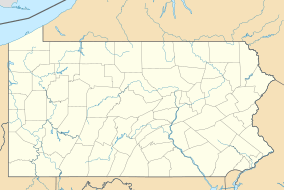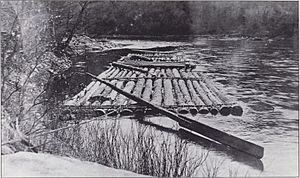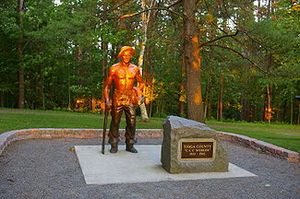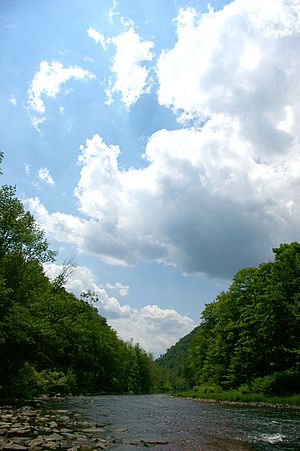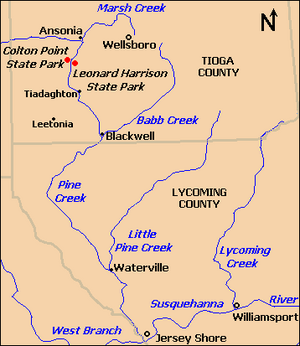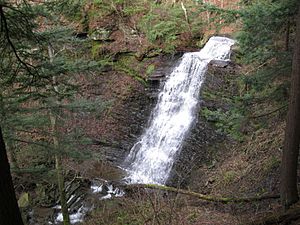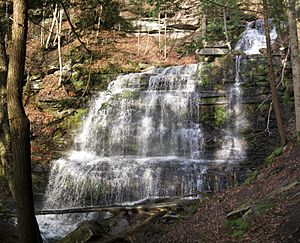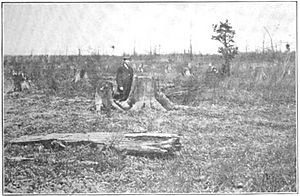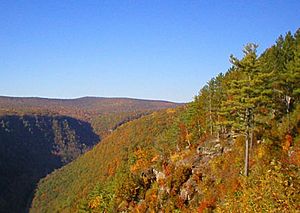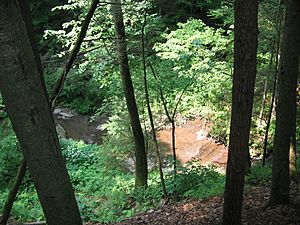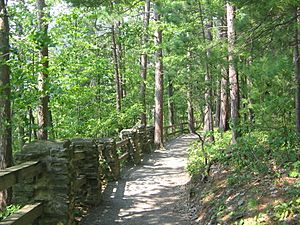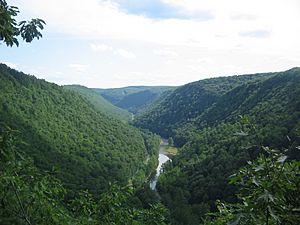Leonard Harrison State Park facts for kids
Quick facts for kids Leonard Harrison State Park |
|
|---|---|
|
IUCN Category III (Natural Monument)
|
|

View north of Pine Creek Gorge, Pine Creek, and Pine Creek Rail Trail from the Leonard Harrison State Park
|
|
| Location | Shippen, Delmar, and Tioga, Counties, Pennsylvania |
| Area | 585 acres (237 ha) |
| Elevation | 1,821 ft (555 m) |
| Established | 1922 |
| Named for | Leonard Harrison |
| Visitors | 142,716 |
| Governing body | Pennsylvania Department of Conservation and Natural Resources |
Leonard Harrison State Park is a 585-acre state park in Tioga County, Pennsylvania. It sits on the east side of the Pine Creek Gorge. This gorge is often called the "Grand Canyon of Pennsylvania" because it's about 800 feet deep and nearly 4,000 feet wide here!
The park is connected to Colton Point State Park on the west side of the gorge. Leonard Harrison State Park is famous for its amazing views of the Pine Creek Gorge. You can enjoy hiking, fishing, hunting, and even whitewater boating here. There are also places for camping. The park is located about 10 miles west of Wellsboro.
Pine Creek flows through the park, carving the gorge over millions of years. Long ago, Native Americans used a path along the creek. Later, lumbermen used it, and then a railroad followed the creek from 1883 to 1988. Since 1996, the 63.4-mile Pine Creek Rail Trail has used this same path.
The Pine Creek Gorge was named a National Natural Landmark in 1968. It is also a Pennsylvania State Natural Area and an Important Bird Area. Pine Creek itself is a Pennsylvania Scenic and Wild River. The gorge is home to many plants and animals, some of which have been brought back to the area.
Even though the Pine Creek Gorge was heavily logged in the past, it is now covered by new forests. This is thanks to conservation efforts by the Civilian Conservation Corps (CCC) in the 1930s. The park is named after Leonard Harrison. He was a lumberman from Wellsboro who later bought land and gave it to the state in 1922 to create the park. The CCC helped improve the park and built many of its first buildings. Since a big advertising campaign in 1936, the park has been a very popular place for tourists. It attracts hundreds of thousands of visitors every year.
Contents
Park History
Early People in the Gorge
Humans have lived in Pennsylvania for at least 12,000 years. The first people were Paleo-Indian hunters who moved around a lot. Later, during the Archaic period (7000 to 1000 BC), people used more advanced stone tools. The Woodland period (1000 BC to 1500 AD) saw people start to live in villages and grow crops.
The first people recorded living near Pine Creek were the Susquehannocks. They were a society led by women and lived in villages with large longhouses. Their numbers dropped due to disease and wars with the Iroquois. By 1675, they had mostly disappeared or joined other tribes.
After this, the Iroquois had control over the land. They lived mostly in New York but used the Pine Creek Path through the gorge. This path connected New York in the north to the Great Shamokin Path in the south. The Seneca tribe of the Iroquois thought Pine Creek Gorge was sacred. They had seasonal hunting camps there but no permanent homes. Other tribes, like the Shawnee and Lenape, also settled in the area.
After the French and Indian War (1754–1763), many Native Americans moved west. In 1768, the British bought this land from the Iroquois. After the American Revolutionary War, most Native Americans left Pennsylvania. However, some small groups stayed in Pine Creek Gorge until the War of 1812.
The Lumber Era
Before William Penn arrived in 1682, most of Pennsylvania was covered in thick forests. These forests had huge eastern white pine and eastern hemlock trees. Early settlers used the timber to build homes and clear land for farming. Over time, the demand for wood grew, and lumber became a major industry in Pennsylvania.
By the early 1800s, lumbering reached the Pine Creek Gorge. The mountainsides were covered with giant trees. Some white pines were 3 to 6 feet wide and over 150 feet tall! Shipbuilders thought pine from Pine Creek was the "best timber in the world" for ship masts. So, these trees were cut first. In 1798, Pine Creek was made a public highway. Log rafts were floated down the creek to the Susquehanna River and then to shipbuilders in Baltimore.
As the 1800s went on, fewer pines were left. More hemlocks and hardwoods were cut and processed nearby. By 1840, there were 145 sawmills in the Pine Creek area. Instead of just picking certain trees, loggers started to cut down all the trees in an area. The first logging near what is now Leonard Harrison State Park happened in 1838.
In 1883, a railroad was built through the gorge, following the creek. This made it easier to move lumber to sawmills. By the early 1900s, almost all the old-growth forests were gone. The gorge was left bare, with only dried-out tree tops. This created a huge fire risk. Many areas burned, leaving the land barren. This led to the area being called the "Pennsylvania Desert." The soil became poor, and floods swept through the area often. Much of the wildlife disappeared.
Park Creation and Growth
George Washington Sears, known as "Nessmuk," was one of the first people to speak out against the logging that destroyed Pennsylvania's forests. In his 1884 book Woodcraft, he wrote about the damage to Pine Creek. He also described visiting "The Point," which is now Leonard Harrison State Park. He said it had a "capital view" of the gorge. A historical marker honoring Nessmuk was placed in the park in 1972.
The park was created thanks to Leonard Harrison. He was a former lumberman and businessman from Wellsboro. In the 1890s, he ran a sawmill in the gorge. After his mill burned down, he focused on tourism. In 1906, he bought 121 acres of land at "The Lookout," which is the current park site. He developed this land and invited the public to enjoy the beauty of Pine Creek Gorge. Harrison gave the picnic grounds to Pennsylvania in 1922.
Even though Harrison donated the park, the Wellsboro Chamber of Commerce made the first improvements. They ran the park for the first 20 years. The state bought other land left by lumber companies in the gorge. This land became the Tioga State Forest, which was created in 1925.
The Modern Era
The park became more well-known over time. From 1933 to 1936, during the Great Depression, the Civilian Conservation Corps (CCC) improved the park. They built picnic areas, restrooms, roads, and trails. They also planted new trees. Many of the CCC-built facilities are still used today.
In 1936, local business owners started a campaign to call the Pine Creek Gorge "The Grand Canyon of Pennsylvania." This helped attract many tourists. By the autumn of 1936, over 300,000 tourists had visited the canyon. In 1937, more visitors came to Pine Creek Gorge than to Yellowstone National Park! The CCC even widened roads and gave tours. A statue honoring the CCC workers was placed in the park in 1999.
After World War II, the state took over the park. They bought more land, increasing its size to 585 acres by 1949. In 1954, it was officially named Leonard Harrison State Park. New restrooms and a visitor center were built in the 1960s. In 1992, Pine Creek was named a state scenic river. This helps protect the gorge in its natural state. In 1997, the park became an Important Bird Area.
The railroad tracks through the gorge were removed in 1988. This old railroad path became the Pine Creek Rail Trail. The first part of the trail opened in 1996, including the 1-mile section in the park. Today, the Pine Creek Rail Trail is 63.5 miles long.
Leonard Harrison State Park has continued to get national attention. The New York Times has featured its "breath-taking views" and trails. In 1968, the Pine Creek Gorge, including Leonard Harrison and Colton Point State Parks, was named a National Natural Landmark. This landmark's plaque is at the park's main lookout.
Pine Creek Gorge: Pennsylvania's Grand Canyon
Leonard Harrison State Park is on the east side of the Pine Creek Gorge, also known as the Grand Canyon of Pennsylvania. Its sister park, Colton Point State Park, is on the west side. Together, they form one large park that includes parts of the gorge and creek. Pine Creek has carved this gorge for nearly 47 miles through the Allegheny Plateau in north-central Pennsylvania. The gorge is about 800 feet deep and nearly 4,000 feet wide in the park.
The Pine Creek Gorge National Natural Landmark includes both state parks and parts of the Tioga State Forest. This special name means the gorge has "superlative scenery, geological and ecological value." It is one of the best examples of a deep gorge in the eastern United States.
The gorge is also protected by Pennsylvania as the 12,163-acre Pine Creek Gorge Natural Area. This is the second-largest State Natural Area in Pennsylvania. Within this area, 699 acres of Leonard Harrison and Colton Point State Parks are specially protected. This Natural Area runs along Pine Creek for about 12 miles.
Pine Creek and the gorge walls are also protected as a Pennsylvania Scenic River. This means the creek is protected from things like dam-building. It helps keep the creek and gorge in their natural, beautiful state.
Geology and Climate
The rocks in Leonard Harrison State Park are very old, at least 300 million years old. But the gorge itself is much younger, forming only about 20,000 years ago during the last ice age. Before then, Pine Creek flowed north. But a giant glacier blocked the creek, forming a lake. When the lake overflowed, the water rushed south, quickly carving the deep gorge we see today.
The park is high up on the Allegheny Plateau. This plateau formed about 300 million years ago when two huge landmasses collided. Even though the gorge looks like mountains, they are not true mountains. Instead, years of erosion have carved this "mountainous" landscape. Harder rocks stayed on top of the ridges, while softer rocks wore away, forming the valleys.
The land here has changed a lot over 400 million years. It was once a shallow sea. Over time, sediment from eroding mountains built up. This sediment turned into the rocks found in the gorge today: sandstone, shale, conglomerates, limestone, and coal.
There are five main rock layers in Leonard Harrison State Park. The youngest, at the highest points, is the Pottsville Formation. Below that is the Mauch Chunk Formation, from which Millstones were once made. Then comes the Huntley Mountain Formation, which is hard rock forming many ridges. Below that is the soft Catskill Formation, which helped form the gorge. The oldest and lowest layer is the Lock Haven Formation, which contains ancient sea fossils.
The park has a continental climate. Winters can be very cold, and summers are warm. The area gets about 36 to 42 inches of rain each year. The highest temperature recorded was 104°F in 1936, and the lowest was -30°F in 1934. July is usually the hottest month, and January is the coldest.
| Climate data for Leonard Harrison State Park | |||||||||||||
|---|---|---|---|---|---|---|---|---|---|---|---|---|---|
| Month | Jan | Feb | Mar | Apr | May | Jun | Jul | Aug | Sep | Oct | Nov | Dec | Year |
| Mean daily maximum °F (°C) | 30 (−1) |
33 (1) |
41 (5) |
54 (12) |
65 (18) |
73 (23) |
77 (25) |
76 (24) |
68 (20) |
58 (14) |
45 (7) |
34 (1) |
55 (12) |
| Mean daily minimum °F (°C) | 13 (−11) |
15 (−9) |
23 (−5) |
33 (1) |
43 (6) |
52 (11) |
56 (13) |
54 (12) |
48 (9) |
38 (3) |
30 (−1) |
19 (−7) |
35 (2) |
| Average precipitation inches (mm) | 1.88 (48) |
1.72 (44) |
2.40 (61) |
2.52 (64) |
3.05 (77) |
4.56 (116) |
3.66 (93) |
2.92 (74) |
3.23 (82) |
2.60 (66) |
2.77 (70) |
2.12 (54) |
33.43 (849) |
| Source: The Weather Channel | |||||||||||||
Plants and Animals
Before logging, the Pine Creek Gorge was mostly hemlock and white pine trees. Many animals that are now gone lived here, like American bison, wolves, lynx, and panthers. There were also many elk, deer, black bears, and beavers. Early explorers even found many rattlesnakes along Pine Creek!
The old forests kept the land and streams cool. The forest soil slowly absorbed rainfall, so the creeks flowed steadily all year. Pine Creek had many fish, including trout. But dams downstream have stopped fish like shad and salmon from reaching the creek. Cutting down the forests destroyed animal homes. Also, a lot of hunting happened, with rewards paid for large predators.
State Natural Area and Wildlife
Leonard Harrison and Colton Point State Parks are part of the Pine Creek Gorge National Natural Landmark. But their status as a Pennsylvania State Natural Area gives them the strongest protection. In this area, logging, mining, and drilling for oil and gas are not allowed. Only foot trails are permitted. The goal is to protect the natural beauty of the Canyon and restore it to its natural state.
The gorge has over 225 kinds of wildflowers, plants, and trees. Some parts have very old forests on the steepest walls. The rest of the gorge has thriving new forests, some over a hundred years old. However, almost 90% of the forest has burned at least once since the clearcutting.
The Grand Canyon of Pennsylvania is famous for its fall colors. Leonard Harrison State Park is a great place to see the leaves change, especially in the first three weeks of October. Red leaves come from red maple and red oak. Orange and yellow leaves are from black walnut and sugar maple.
Over 40 kinds of mammals live in the Pine Creek Gorge. The park's large forests are home to white-tailed deer, black bears, wild turkey, and squirrels. Less common animals include bobcats, coyotes, and timber rattlesnakes. Pine Creek has over 26 kinds of fish, like trout and smallmouth bass.
Several animals have been brought back to the gorge. White-tailed deer were brought from Michigan to reestablish their population. Now, there are so many deer that they sometimes eat too much in certain areas. River otters were successfully reintroduced in 1983 and now breed in the gorge. Fishers, a type of weasel, were also brought back to help control smaller animals. Elk sometimes wander near the canyon's west side.
However, some harmful insect species have also arrived, like gypsy moths, which eat tree leaves, and hemlock woolly adelgids, which kill hemlocks.
Important Bird Area
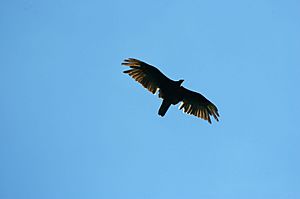
Leonard Harrison State Park is part of Important Bird Area #28. This area is important for bird conservation. It includes the state parks and surrounding state forest lands.
Bird watchers have seen 128 different bird species in this area. This is because there are large forests and many different types of habitats. The open water of Pine Creek is used by many birds, especially bald eagles.
Besides bald eagles, which live here all year, the area is home to belted kingfishers, scarlet tanagers, and wood ducks. Many ospreys use the gorge during their spring and fall migrations. The woodlands have ruffed grouse, Pennsylvania's state bird, and wild turkeys.
Many types of warblers are found in Leonard Harrison State Park. These include Pine, Black-throated Blue, and Black-and-white warblers. These smaller birds are often heard more than seen, as they stay away from the trails.
Recreation
Trails
Leonard Harrison State Park is a great place for hikers. The park has 4.6 miles of trails. These trails can be very rugged and steep, and some areas can be slippery.
- Overlook Trail is a 0.6-mile path to Otter View. This trail passes by reminders of the CCC's work, like a red pine plantation.
- Turkey Path is a difficult 2-mile trail (down and back). It follows Little Fourmile Run down the side of the canyon, dropping over 800 feet to Pine Creek. This trail has several waterfalls. Hikers should stay on the path to protect the plants and prevent erosion. There is also a Turkey Path from Colton Point State Park on the west side of the gorge. When the water is low, you can carefully cross Pine Creek to connect the two parks.
- Pine Creek Rail Trail is a 63.4-mile rail trail that goes through the Pine Creek Gorge. One mile of this trail is in Leonard Harrison and Colton Point State Parks. USA Today once called this trail one of the "10 great places to take a bike tour" in the world!
Camping and Picnics
Camping is popular at Leonard Harrison State Park. The park has updated electric sites for RV campers. The campground has picnic tables and fire rings. The park also has almost 100 picnic tables for day use, with some in shelters.
Hunting, Fishing, and Whitewater
Hunting is allowed on about 250 acres of Leonard Harrison State Park. Hunters must follow the rules of the Pennsylvania State Game Commission. Common animals to hunt include ruffed grouse, eastern gray squirrel, wild turkey, white-tailed deer, and black bear.
Fishing is also allowed in the park. Anglers must go down the Turkey Path to reach Pine Creek. Pine Creek is stocked with trout during trout season. Other fish found here include smallmouth bass. Several small trout streams are also in the park. Famous fishermen who visited Pine Creek include President Theodore Roosevelt.
Pine Creek is known as one of Pennsylvania's most famous canoe streams. Many people decide to boat on it after seeing the amazing views from Leonard Harrison and Colton Point state parks. The park has 1 mile of Pine Creek, which is Class 1 to Class 2 whitewater. Boaters usually start their trip outside the park.
Nearby State Parks
Leonard Harrison State Park is mostly in Shippen Township. It is 10 miles west of Wellsboro. Here are some other state parks within 30 miles:
|
|


